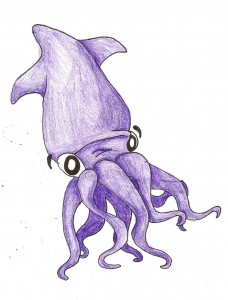It happens every few years. Scientists haven’t figured out why the Humboldt squid invade the west coast every once in a while. The best observation is they may be chasing krill.
The squid themselves are carnivorous invertebrates that live at depths of 200 to 700m. They are fished commercially in areas such as Peru and Mexico. The general habitat for these squid is from California all the way to Tierra del Fuego, all the way at the tip of South America.

“I’m not any professional at fishing, but I’ve fished enough to know that squid in the water can be a good or a bad thing; it all depends,” freshman Sam Seaton said. “If they are sneaky, they can steal your bait and you might sit there for hours wondering why nothing is biting, to find out your bait has been gone.”
Thomas Sterner, owner of The Davey’s Locker, a fishing company in Orange County, California, also said having squid in the area can be a good or a bad thing.
“Economically for the sport-fishing fleet it’s a great thing,” Sterner said. “The amount of people they bring is a huge boost for the exposure of the companies. The squid, depending on time of year they show up, can be a really bad thing as well. If the squid show up during summer, it can ruin the normal seasons by scaring off or consuming the fish the sport-fishing fleets would normally be targeting. If they show up during spawning times of other fish, the effects can last years. Squid from December through March is perfect.”
They are nicknamed “diablos rojos.” or red devils, by locals because of their deep red coloring.
“Personally I would not feel safe at all swimming with Humboldts. There is a reason in Mexico they call them diablo rojo,” Sterner said. “With a beak like a parrot and a ring of teeth in each sucker, the damage they can cause should leave anyone wary of swimming.”
The squid move by ejecting water from their triangle-like fins near their heads. Suction pads lined with sharp teeth are used to grab prey and bring them towards their sharp, large beak. The size of the squid varies just like any other animal. They can be extremely small or as much as three to four feet long.
“The Humboldt squid are very veracious predators and for the most part they will try to eat anything they can, even each other,” Sterner said. “This can have huge impacts on local fish stocks when they come into our area. The size of the squid matters as to what effect they will have in a particular location.”
Sterner said something should be done about the migration, but there isn’t much that can be done.
“Unfortunately, there is not much we can do about the migration. Humboldts can travel in such deep depth that trying to prevent their migration would be financially astronomical,” Sterner said. “The best bet we have at trying to slow the migration would be to protect the species that consume them, mako shark, swordfish, Rissos Dolphin, etc.”
Because they are carnivorous, sometimes they cause issues with fishermen. The squid can eat massive amounts of the fishermen’s daily catch. On the other hand, the squid themselves can be caught. They are fairly rare, considering the Northern parts of California hardly ever see them. Because of this they can be sold for a decent sum of money.
“Many people actually pursue catching squid,” Seaton said. “They sell for more in other places. The only problem is you have to be good at catching them and have at least some experience to be good at catching squid. I guess once you get good at something, you should keep doing it, so if it’s squid you like, it’s squid you get.”
The squid can also be a nuisance to swimmers and divers. Although they are more curious than aggressive, they can constantly swim up to humans to grab them, observe them, or do whatever squids do.
Sterner said he doesn’t think we’re effecting the population of the squid very much even after the countless fishing.
“I do not believe our taking of the squid for the short time they are in our area really has a significant impact on their population,” Sterner said. “Humboldt squid are prolific breeders with a lifespan of only one to two years, so the population turns over rapidly. The Humboldts also look to be expanding their range more northerly, which would indicate a larger population when the population south have not noticeably been declining.”







